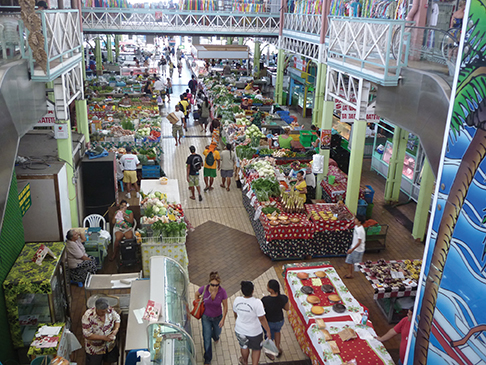A guide to stocking up, storing food and eating well underway (published May 2015)
Provisioning a cruising sailboat can seem like a daunting task. Trying to predict where you will be able to restock after leaving a major port can be stressful. Having to plan what you and the crew will eat for days, weeks or even months in advance is enough to make the most experienced liveaboard sailor procrastinate. Location, dietary requirements, facilities on board and how you cook all play a part in how you stock your boat. And there is no “right” way to provision or a magic list of “must have” foods.
Sailors have come a long way from hard tack and salt fish, but sometimes it seems like tossing the dock lines means you need 100 ways to cook cabbage and a taste for canned mystery meat. Not so. Having a well-stocked pantry, knowing how to buy and store fresh goods and a willingness to be creative and flexible is all you need to make cooking and eating on board stress free. All it takes to provision is a bit of planning, some smart choices and a lot of schlepping.
“We may find in the long run that tinned food is a deadlier weapon than the machine gun.”—George Orwell
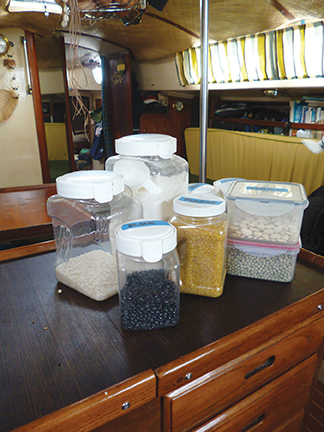
A good place to start when provisioning is in the pantry. Non-perishables like canned goods, dry-stores and general pantry items have a long shelf life and can be bought well in advance of departing port, relieving some of the last minute anxiety. I often add a few extra cans to my weekly provisioning trips instead of trying to lug everything in one big, heavy order. As I stow and sort I can see what more I need to buy or if I have forgotten anything.
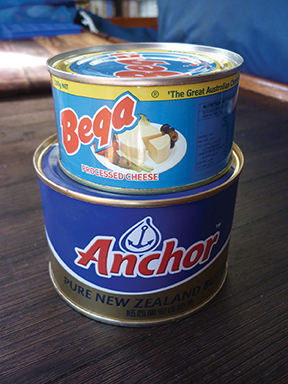
Preserved foods have always been a necessary evil on a sailboat. Although quality pre-packaged foods are easy to find these days, shelf stable products can also be crammed with salt and other preservatives. It pays to take a few minutes to read labels and try to make not only convenient but healthy purchases.
Also consider that what you eat on shore might not translate to how you eat on board. Back in the early days I stocked up on cans of soup thinking they’d be quick, hot meals underway. As it turns out, it is not so easy to keep scalding hot soup in a pot when the boat is being tossed around at sea. Soup was scratched off the provisioning list.
Things that are regularly on my “canned” shopping list are tomatoes and tomato paste, corn and baby corn, beets, a variety of beans and lentils, tuna, salmon, anchovies and various canned fruits for emergencies. There are a variety of canned meats and vegetables available; I recommend trying some out and deciding what you find palatable. And don’t be afraid to try different brands or unfamiliar things. We’ve found cheese, maple syrup, whole duck, hotdogs, even butter all in cans that are convenient to store.
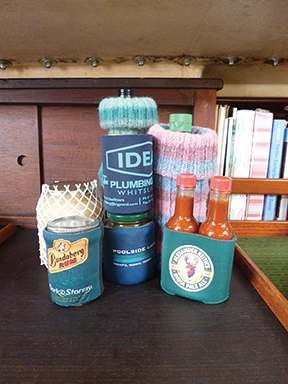
Lots of good quality food items can only be preserved in glass because of their acidity and shouldn’t be overlooked. Don’t automatically pass up the sundried tomatoes or strawberry jam because they are only sold in a glass jar. People have been sailing for hundreds of years and glass was used for food storage long before cans and plastic were even invented. Wrapped in bubble wrap or non-skid, placed inside a clean sock or beer coozy, jars will travel just as well as cans on a sailboat. Besides, if you don’t carry glass bottles where do you keep the rum?
Don’t forget about the everyday items like oil, vinegar, mustard, mayonnaise, ketchup, honey, peanut butter, molasses, tea and coffee. Some of these things can be found in larger cans or bottles and decanted for use in the galley or, if spoilage is a concern, be sure to buy several smaller containers that will easily fit in your fridge once opened.
“It is thrifty to prepare today for the wants of tomorrow.”—Aesop
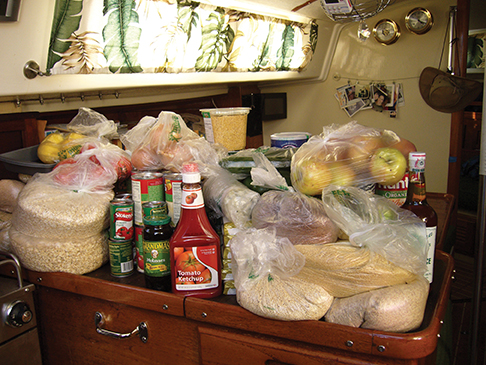
Buying in bulk is a great way to save cash and cut down on packaging. It’s hard to resist a bargain, but you’ll be throwing money away buying food no one wants to eat. Before splashing out on a 64-ounce can of garbanzo beans or a year’s worth of powdered mashed potatoes, try them first.
You can’t go wrong stocking up on staples like flour, rice, sugar, oats, cornmeal, couscous, millet, quinoa, powdered milk, raisins, dried fruit, pasta, dried beans and lentils. It is worth investing in some quality airtight containers to store these items in. Because not only will having your dry stores organized make it easier to see and use what you have, but proper storage will prevent spoilage and bugs. After filling the container in the dry stores I vacuum pack the excess bulk items into container-sized portions. This makes refills easy and prevents dry items from getting damp when stowed in other holds.
This is also a good time to consider what you and your crew like to snack on, as it is important to have a selection of easy to eat food on board, especially when on passage. Nuts, dried fruit, granola bars, crackers and other grab ‘n’ go food is often sold in more economical “jumbo” packs, and worth the trip to the warehouse store for the savings.
“Good food is very often, even most often, simple food.”
—Anthony Bourdain
You want to stock things that are versatile, but that doesn’t mean they have to be boring. Buying a few speciality items is an easy way to spice up your mealtime. A simple can of beans can make an appearance at dinner or be turned into a delicious dip for cocktail hour. Smoked mussels and tins of octopus or squid are perfect for lunchtime picnics on the beach. And a bottle of chillies, a special jar of chutney or a can of olives can do a lot to brighten up a boring dish and boost morale.
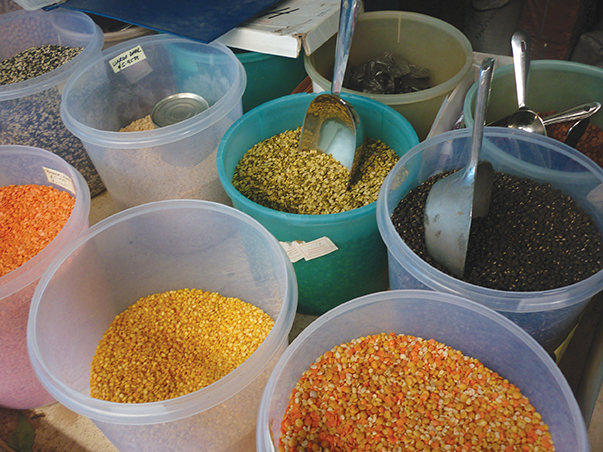
Herbs and spices are a perfect way to add big flavor to your cooking. They can also be a great way to leave with a little of the places you visit without taking up a lot of storage space. So explore local flavors and grocery stores. Keep in mind that the longer spices sit around, especially in hot climates, the less flavor they will impart to your cooking. So try to buy only what you’ll use in four to six months and keep them in airtight containers.
“If it has four legs and it’s not a table, eat it.”—Cantonese saying
Shopping for meat can sometimes be the hardest and most expensive part of provisioning, but there are a few tricks I use to cut down on cost without skimping on quality.
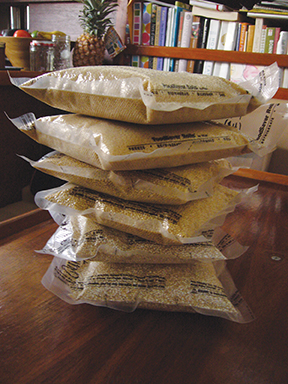
If you have a good knife, a vacuum packer and a sense of adventure, ordering larger cuts of beef, pork or lamb and breaking them down yourself is a cost effective way to buy meat. Doing some basic butchering yourself allows you to control portion sizes and reduces waste. The same rule applies for fowl; a whole fresh duck or chicken will yield more meat for less money than forking out for boneless skinless breast or thighs, and it is not difficult to debone or butterfly a bird.
If handling meat makes you squeamish, talk to a local butcher. In most cases I have found that given a little advanced notice butchers are willing to portion, cryovac and freeze orders for yachties with little or no extra cost. Even if you have to pay for these services, they are worth it. Properly vacuum packed meat will last much longer fresh or frozen, and having large orders pre-frozen gives the onboard fridge or freezer a little head start and your batteries a break. And don’t be afraid to try local meat, we have yet to be disappointed by shopping at local butchers throughout our travels.
“Shake the hand that feeds you.” —Michael Pollan
Fresh fruit and vegetables are the last things to stock up on before leaving port. No matter how large the vessel, refrigeration on a boat is always limited. Going the extra mile, sometimes literally, will ensure that the precious produce you buy will last as long as possible.
Most crops thrive in temperate climates and need sunshine to grow. As soon as fruit and vegetables are harvested and refrigerated they need to be kept chilled or will quickly rot. Most modern grocery stores are air-conditioned and receive fresh goods that have been shipped under refrigeration. This means produce purchased from these stores must be kept at or below the temperature inside the store or consumed quickly.
An easy way to avoid spoilage and get the most bang for your buck is to buy from a local market or roadside stall. Sourcing as much produce as you can from local markets means you are getting the freshest possible fruit and vegetables that are picked when they are ripe. Not only will things taste great but it means you can store as much as possible out of the fridge.
All but the most delicate lettuce will survive days without refrigeration. Of course, we know the hearty cabbages, pumpkins, potatoes, onions and other root veggies do well in a dark cupboard, but I have also successfully kept zucchini, cucumbers, peppers, tomatoes and assorted fruit on the countertop or in baskets for up to a week, depending on the temperature. Make sure you buy your produce fresh, unrefrigerated and without splits, nicks or bruises. If your root vegetables are a little dirty try not to wash them until use, the dirt acts as a natural defense against rot. Store produce with ample air circulation and check it daily. At the slightest sign of decay, remove the fruit or veggie from the basket and either put it in the fridge or in the pot.
Buying direct from the grower will also give you a chance to ask questions and try new things. Don’t know what to do with breadfruit (a starchy green veg the size of soccer ball that grows on trees)? Ask the woman who is selling them how she cooks them. Not sure how to pick a ripe rambutan or carambola? Watch the little old man as he haggles at the fruit stand. Wondering how to make a proper curry? The lady selling the Indian spices will probably have a few tips for you. I have always found that the people who sell food also like to talk about it and will welcome any inquiries from a friendly face.
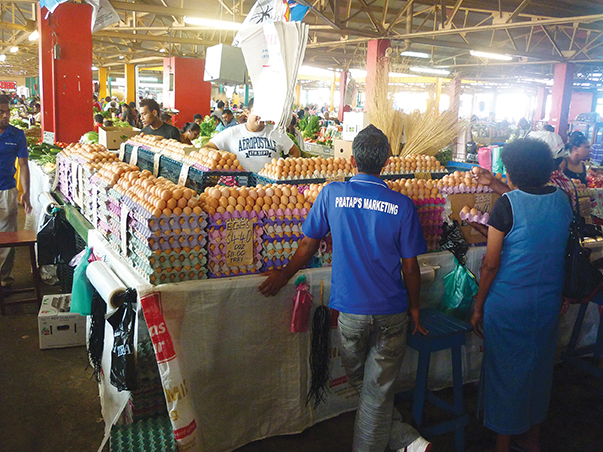
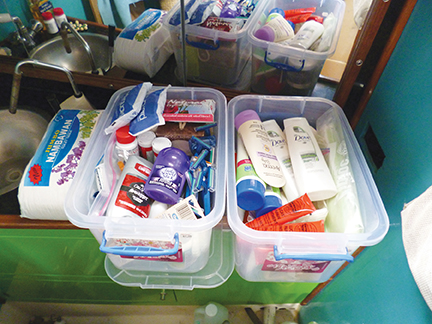
Markets are also the best place to get fresh eggs, which can keep up to a month unrefrigerated and without too much attention. It is recommended that you turn them every day to prevent the air sack from sticking to the shell, but I usually forget to do that and have rarely had a problem. I often find a stray chicken feather or smear of poop on an egg from a small producer and view it as the signature of a happy chicken.
“One cannot think well, love well, sleep well, if one has not dined well.”—Virginia Woolf
When we hear the word provisioning we automatically think of foodstuffs, but there are a host of other consumables that have to be considered. Water is very important. Know your tankage and your replenishment methods (rain collection, watermaker, trips ashore) and before leaving on an extended trip pay attention to your weekly water consumption. These will determine if you need to stock extra water on board for the trip. I recommend having at least some bottled water for emergencies.
A few other items to think about are laundry soap, dish soap, cleaning supplies, air fresheners, batteries, stationary supplies, toothpaste and toothbrushes, toilet paper, deodorant, body wash, soap, shampoo and conditioner, razors and shaving cream, diapers, feminine hygiene items, condoms, sunscreen and moisturizer. Please remember that everything you put down the drain ends up in the ocean, so spend the extra cash and buy low impact, natural products that are easier on the environment when available.
Most boats keep a comprehensive medical kit on board and major ports are a great place to replace incidentals such as Band-Aids, painkillers and seasickness medications that were used recently. Before setting sail on a long passage it is a smart idea to check expiration dates of any medications, and purchase any specialty items that might be needed for your next destination i.e. Malaria pills.
Often while planning for the future the present is overlooked, but budgeting for time is just as important as budgeting for money. The buying part of provisioning is only half the battle, once back on board you still need to stow all that booty. Make sure you give yourself enough time to unpack and put everything away properly without the pressures of everyday boat work looming over you. This could mean treating yourselves to dinner ashore on a particularly long day or thinking ahead and having a ready-made meal in the fridge.
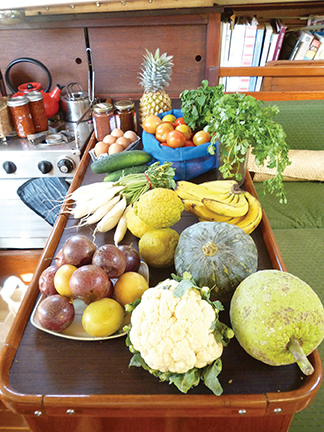 Provisioning well is important. It is not just about buying food, it is about making sure that you stock enough supplies to sustain you and your vessel no matter where the weather takes you. It is also about being considerate to the islands and villages that you decide to visit. Sailing destinations are often seasonal and while having several visiting yachts in the harbor may boost the local economy, it can also put a great strain on local supples. Making sure that your boat is well-stocked means you can spend your time worrying about which pristine anchorage to stop at, not if you have enough supplies to stay another week in paradise.
Provisioning well is important. It is not just about buying food, it is about making sure that you stock enough supplies to sustain you and your vessel no matter where the weather takes you. It is also about being considerate to the islands and villages that you decide to visit. Sailing destinations are often seasonal and while having several visiting yachts in the harbor may boost the local economy, it can also put a great strain on local supples. Making sure that your boat is well-stocked means you can spend your time worrying about which pristine anchorage to stop at, not if you have enough supplies to stay another week in paradise.
Heather Francis was born in Nova Scotia, Canada. She and he Aussie partner, Steven Hertik, bought their Newport 41 Kate in 2008 and have been sailing ever since. For more of their adventures log onto www.yachtkate.com
TIPS AND TRICKS
• Onions and potatoes taste great together but when stored in the same compartment will quickly rot.
•Bananas give off gas as they ripen and will ripen not only other bananas but also other fruits and vegetables nearby. This can be used to your advantage with green avocados and tomatoes but can mean you’re in for a lot of banana bread.
• An easy way to keep ginger: peel it, cut it into one inch chunks and pack it into a jar. Pour in enough rum or vodka to cover. The ginger will stay fresh for months, the alcohol will burn off when cooked and the leftover rum/vodka is delicious in cocktails!
• Finely chop fresh herbs such a basil, cilantro and parsley, place in a jar and cover generously will oil. Stored in the fridge they will retain their color and flavor for weeks as long as they are submerged in the oil.
•You can’t have enough white vinegar on board. Not only is it good in the galley but a cup down the head once a week will prevent your plumbing from getting clogged. It is great for cleaning as it cuts through salt and prevents mold. And it will eliminate odors in your laundry when added to the rinse water.
•To avoid weevil infestations in your wheat products add a handful of bay leaves to flour and pasta containers, and sprinkle throughout galley cupboards. If you find one weevil there will be many more in your future as they lay their eggs inside wheat products. Discarding all of the flour/pasta you found it in is the only way to get rid of them.
•Spending a little time researching your destination can save you time and money. What food stuffs you can and can’t bring into a country varies around the world. Having a freezer full of meat or fridge full of fresh veggies confiscated by the authorities is not a happy way to end a passage.
•A vacuum packing machine might seem like a bit of an expense when purchased but when provisioning, especially for remote locations, will prove itself as a good investment. Make sure to stock up on extra bags.
•Restocking your pantry is a perfect time to rotate stock and clean holds. Take time to inspect cans for rust or bloating, and make sure the “button” on all jar lids are concave. Discard, without opening, anything that seems suspect.















